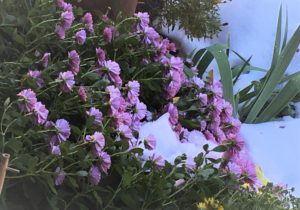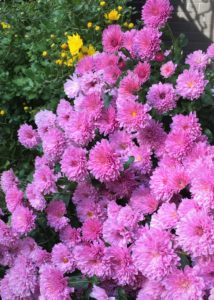A Nor’easter swept through the region on Thursday. The forecast gave the impression that it would be like the first snow in most years, coming down lightly and quickly melting away. Defiantly, six inches of wet snow dropped down within hours, holding commuters hostage. Leaves that were hanging on to the last days of autumn, weighted by snow and ice forcing the branches to bow to the ground. Although I had finished winter preparations in the garden, there was no telling of any possible damages.

Stepping out of my building in the morning, the sun was out with its sarcastic smile. The temperature was high enough that most of the icy accumulation had dissipated. Looking up to the flowerbeds on the terrace, pompon mums already stuck their heads out trying to reclaim their territory.

A few years ago, the nice lady at the garden center suggested for me to plant the mums directly on the ground so they would come back every year. I did so gladly. And the plants responded in kind. In late autumn when most plants go dormant, these sturdy little darlings continue to show off their vibrant colors enthusiastically. People walking by often stop to admire and smile at them.
Chrysanthemums with large flowers and long stems are more popular in Asia. Their elegance and their cold-resistant nature brought them praises from writers and artists. They are one of the “four gentlemen” in Chinese paintings. The others are orchid, bamboo, and plum blossom. Orchids represent the spring season; bamboos, summer; chrysanthemums, autumn and plum blossoms, winter.
I first planted chrysanthemums in high school: “Professional training” classes were part of the government mandated curriculum. Agriculture practice was one of the options offered at my school. Since we all planned to attend college after graduation, no heavy farming equipment was introduced in class. Instead, we learned to plant vegetables and flowers.
Our garden was near the dormitory. Technically it’s at the edge of the school property but it was OUTSIDE of the fences that separated the campus and the outside world. It faced the grand palace of the National Museum. There was a traditional farmhouse on one side, probably belonging to the farmers that tended the rice paddies on the bottom of the hills.
After harvesting green beans and daikon radishes that we planted earlier in the semester, we were given shoots of chrysanthemums to replenish the ground. The earthy scent of the young plants blended perfectly with the smell of the freshly turned soil.
Every day the garden gate would be unlocked after the last class period until dinner time, so we could care for the flowers. The cool evening breeze always had a calming effect on me. I would pick up a bucket, walking over to the babbling brook, our irrigation source. Before filling up the bucket, I loved to pause for a moment, just to listen to the sounds of water trickling downstream and watch the evening clouds.
My flowers were purple, not at all my favorite color. Yet, I was content watching them growing from little knots on the top of the stems to blooms the size of a soup mug. When I brought the cut flowers home, their scent followed me onto the bus and through the streets.
Pompons in my garden don’t seem to have very strong scents. They also lack the stately manner. Yet, they are just as resilient as the larger varieties. I wish, for them, a late arrival of winter coldness.
